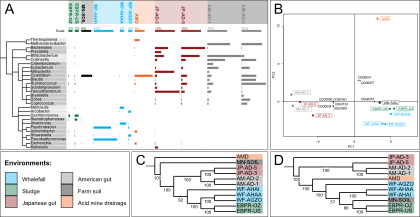- Frequentry Asked Questions
- 1. The Basics
- 2. Installation
- 2.1. How do I install Smash?
- 2.2. My laptop is not powerful to analyze big metagenomes. What do I do?
- 2.3. Smash uses SQLite by default. I have huge metagenomic datasets. Can I use MySQL?
- 3. Smash versions and upgrading to a newer version
- 3.1. What do the version numbers mean?
- 3.2. How can I upgrade Smash to a newer minor version?
- 3.3. How can I upgrade Smash to a newer patch?
- 4. Analysis
- 4.1. How can I load Roche 454 metagenomic data that is already assembled by Newbler?
- 4.2. I have a very complex metagenomic sample and I want to skip the assembly step.
- 4.3. How do I find out what species, genera and families are in my metagenomic data?
- 4.4. How do I find out what genes are in my metagenomic data, and what these genes do?
- 4.5. How do I compare multiple environmental samples?
Frequentry Asked Questions
This is a list of questions I get asked by a lot of people. If you have a question, check this list first. If there is no answer, then write to me and I will give you the answer. If it is useful for general users, I might add it here as well.
1. The Basics
1.1. Is Smash free?
Yes, Smash is free for non-commercial use. Just download it and use it. But please cite us if you use Smash in any of your publications.
2. Installation
2.1. How do I install Smash?
Please see the "installation manual" for details.
2.2. My laptop is not powerful to analyze big metagenomes. What do I do?
Install Smash on a cluster. Assuming that Smash is installed on an NFS file system that can be accessed by all nodes in the cluster, you could be running several steps in parallel and do not have to be limited by the diskspace of your laptop. Please see "Installation on a cluster" in Special Topics for details.
2.3.
Smash uses SQLite by default.
I have huge metagenomic datasets.
Can I use MySQL?
Yes,
of course.
Although SQLite is used by default,
it should be used for reasonably sized metagenome samples.
For example,
collections not exceeding a few hundred thousand metagenomic reads will run fine using SQLite.
If you have more than this,
then performance will be an issue,
and we recommend that you use MySQL.
Please see "Configuring MySQL database" in Special Topics.
3. Smash versions and upgrading to a newer version
3.1. What do the version numbers mean?
Smash has major and minor version numbers and an optional patch number. For example, v1.6p2 denotes major version 1, minor version 6 and patch 2.
3.2. How can I upgrade Smash to a newer minor version?
We do not recommend a simple upgrading of minor version number. Design principles may change between different minor versions. For example, v1.5 cannot be simply upgraded to v1.6. This would involve a more elaborate upgrade, which will be documented here soon.
3.3. How can I upgrade Smash to a newer patch?
Applying just the patch (meaning upgrading to the latest patch number) is very simple. Please see "Applying a patch" in Special Topics. This is because the internal data structure, database design and other design principles do not change within a minor version number. Within a given minor version, you can apply any patch, including a lower version. For example, v1.6p2 can be up/downgraded to 1.6p3 or 1.6p1 very easily following instructions from "Applying a patch" in Special Topics. Rest assured that if you reextract to the same directory as before, the long downloads for the KEGG and eggNOG databases will not be repeated since those files must already exist in the download directory.
4. Analysis
4.1. How can I load Roche 454 metagenomic data that is already assembled by Newbler?
Please see "Loading an assembly from Newbler" in Special Topics.
4.2. I have a very complex metagenomic sample and I want to skip the assembly step.
Please see "Skipping assembly" in Special Topics.
4.3. How do I find out what species, genera and families are in my metagenomic data?
Please see "Phylogenetic annotation of samples".
4.4. How do I find out what genes are in my metagenomic data, and what these genes do?
Please see "Functional annotation".
4.5. How do I compare multiple environmental samples?
E.g., different human gut metagenomes or even a gut metagenome and a skin metagenome?
Please see "Comparative metagenomic analysis".


